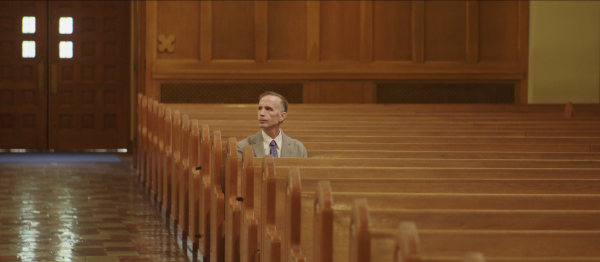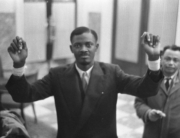This intense documentary centers on the teaming up of its filmmakers, a professional drama therapist, and a group of men who survived the horrific: child sexual abuse at the hands of pedophile Catholic priests. The goal of the collaboration is to make a series of short films based on what happened to allow these middle-aged men to take back moments of their childhood and attain a degree of catharsis.
None of the staged scenes are graphic, and some are more impressionistic than others. Our first glimpse, which occurs early on, features an altar boy who gets shamed by a clergyman, who turns out to have a literal monstrous side. An interesting creative decision was made to have one of the survivors play the demonic priest. His name is Tom Viviano. Though not a professional actor, he, like the five others taking part in this project, has a strong on-screen presence.
These short films-within-the-film, which are interspersed throughout, have a polished and professional feel: crisp visuals, rich colors, booming sound. Director Robert Greene doesn’t do much to introduce them, yet we know instantly whenever we have switched between art and real life; the latter has a more loose, traditional documentary feel. Most of the film actually consists of behind-the-scenes of the creative processes, during which the subjects and the therapist toss ideas and back and forth. Not surprisingly, from the start there is tension arising from how personally invested everyone is. Some of the men want their scenes to convey a specific message while others still need to figure that out.
All of the participants still feel their trauma deeply. To his credit, Greene allows his subjects their space. There are times they are clearly anxious, but the filmmaker conveys that anxiety indirectly, such as a cutaway shot of a man’s hands trembling unbeknownst to him. The survivors who make the strongest impressions include the aforementioned Viviano, a gentle giant; Ed Gavagan, who initially comes across as cool and a bit aloof, but whose façade crumbles almost the moment he’s back in a church setting; and Mike Sandridge, who has a gait seemingly weighed down by the rage he still carries toward his abuser and those who protected him. He’s the most openly confrontational of the men.
By the mid-section, the narrative starts to follow a pattern of prep scenes, filming, emotional catharsis, and then repeat. Yet Procession never becomes monotonous because each man’s journey has its own twists and turns. One, for example, finds the actual house where the abuse happened, but as it turns out, that discovery isn’t what he needs for genuine closure. Another survivor, a professional location scout, works tirelessly to find churches where they can film as well as the priests’ homes if that’s where the terrible acts occurred, and he eventually brings along his brother as they were assaulted by the same priest.
Greene’s last documentary, Bisbee ‘17 (2018), was also about the use of art to process trauma, specifically, what amounted to an ethnic cleansing in an Arizona town 100 years prior. As was the case in that film (as well as Greene’s excellent Kate Plays Christine from 2016), a key theme is the blurring of the line separating art and real life, although that line is obliterated from the start this time. As a result, there is a greater focus on the men supporting each other emotionally as they revisit some of the worst days of their lives, and seeing their friendships deepen amounts to some of the film’s most touching moments.
Another trait Procession shares with the director’s other features (and something that frankly, he doesn’t get enough credit for as a filmmaker) is how it deals with controversial material without veering into exploitation. Throughout, there are captions at the bottom of the screen that reveal the present-day fates of the priests who molested the main subjects, but they’re rendered in a relatively subdued font and not accompanied by voice-over. As such, they remind us of the terrible acts they committed without taking the focus away from the survivors.







Leave A Comment